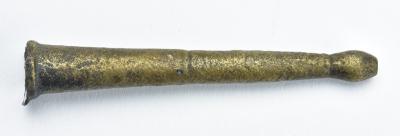Enema Syringe Tip Physical Object
Accession Number
1986.008.1692Category
Alternate object names
Syringe TipCreation Date
circa 1620Materials
Description
A bronze “needle” from a large piston syringe. The needle was fitted at the top of a domed head, which capped a cylindrical, barrel-shaped body. A plunger inside the body forced liquid contents out through the needle. Large syringes were commonly used to administer enemas. The needle has a slightly expanded and rounded, egg-shaped tip for easier insertion.Dimensions
19.97 g Weight
7.1 x 1.4 x 0.7 cm
Exhibition Label
Case Caption (2023):The Surgeon
Both Cecilio de Ribera aboard the Nuestra Señora de Atocha and Juan de Mercado on the Santa Margarita were ship’s surgeons. At this time, a surgeon was often a barber who had acquired a few additional skills rather than a man with medical training.
He would have few medicines to offer. His resources would include basilicum powder (made from basil) to speed the healing of a wound and poultice ingredients for sores or strains. The lack of fresh food in sailors’ rations would lead to digestive problems in the short term or even scurvy during a long voyage. Many minor illnesses were treated with enemas, whether truly appropriate or not.
In addition, the surgeon would know how to clean a sword cut, dig out a musket ball, or even pull a tooth. He might have to go as far as amputating the limb of an injured sailor. Dipping a man’s freshly severed stump in hot pitch to seal the wound would be as close to hygiene as the operation might come.
Object Caption (2023):
Clyster (Enema) Tips
Bronze (c.1610)
Gifts of Jamestown Inc.
1986.008.0132, 1986.008.1692
